Related Research Articles

Sir Edward William Elgar, 1st Baronet, was an English composer, many of whose works have entered the British and international classical concert repertoire. Among his best-known compositions are orchestral works including the Enigma Variations, the Pomp and Circumstance Marches, concertos for violin and cello, and two symphonies. He also composed choral works, including The Dream of Gerontius, chamber music and songs. He was appointed Master of the King's Musick in 1924.

Robert Fuchs was an Austrian composer and music teacher. As Professor of music theory at the Vienna Conservatory, Fuchs taught many notable composers, while he was himself a highly regarded composer in his lifetime.

Edward Elgar's Cello Concerto in E minor, Op. 85, his last notable work, is a cornerstone of the solo cello repertoire. Elgar composed it in the aftermath of the First World War, when his music had already gone out of fashion with the concert-going public. In contrast with Elgar's earlier Violin Concerto, which is lyrical and passionate, the Cello Concerto is for the most part contemplative and elegiac.
E-flat major is a major scale based on E♭, consisting of the pitches E♭, F, G, A♭, B♭, C, and D. Its key signature has three flats. Its relative minor is C minor, and its parallel minor is E♭ minor,.
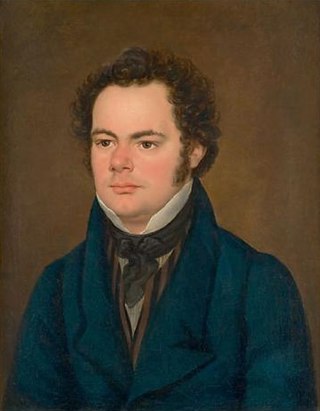
Franz Schubert's final chamber work, the String Quintet in C major is sometimes called the "Cello Quintet" because it is scored for a standard string quartet plus an extra cello instead of the extra viola which is more usual in conventional string quintets. It was composed in 1828 and completed just two months before the composer's death. The first public performance of the piece did not occur until 1850, and publication occurred three years later in 1853. Schubert's only full-fledged string quintet, it has been praised as "sublime" or "extraordinary" and as possessing "bottomless pathos," and is generally regarded as Schubert's finest chamber work as well as one of the greatest compositions in all chamber music.
Orlando Cole was an American cello teacher who taught two generations of soloists, chamber musicians, and first cellists in a dozen leading orchestras, including David Cole, Lynn Harrell, Jonah Kim, Ronald Leonard, Lorne Munroe, Peter Stumpf and Marcy Rosen.
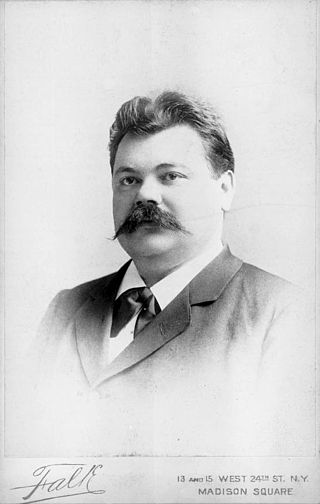
Adolph Davidovich Brodsky was a Russian Empire violinist who later moved to the United States.
The Quintet in A minor for Piano and String Quartet, Op. 84 is a chamber work by Edward Elgar.
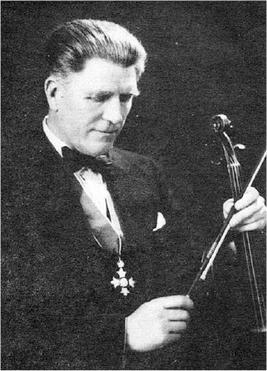
Albert Edward Sammons CBE was an English violinist, composer and later violin teacher. Almost self-taught on the violin, he had a wide repertoire as both chamber musician and soloist, although his reputation rests mainly on his association with British composers, especially Elgar. He made a number of recordings over 40 years, many of which have been re-issued on CD.

Felix Adrian Norman Salmond was an English cellist and cello teacher who achieved success in the UK and the US.
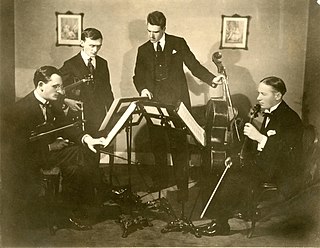
The London String Quartet was a string quartet founded in London in 1908 which remained one of the leading English chamber groups into the 1930s, and made several well-known recordings.
The Stratton String Quartet was a British musical ensemble active during the 1930s and 1940s. They were specially associated with the performance of British music, of which they gave numerous premieres, and were a prominent feature in the wartime calendar of concerts at the National Gallery. After the War the group was re-founded as the Aeolian Quartet.

Arthur Catterall was an English concert violinist, orchestral leader and conductor, one of the best-known English classical violinists of the first half of the twentieth century.
William Henry Reed MVO was an English violinist, teacher, composer, conductor and biographer of Sir Edward Elgar. He was leader of the London Symphony Orchestra for 23 years (1912–1935), but is best known for his long personal friendship with Elgar (1910–1934) and his book Elgar As I Knew Him (1936), in which he goes into great detail about the genesis of the Violin Concerto in B minor.

Caroline Alice, Lady Elgar was an English author of verse and prose fiction, who married the composer Edward Elgar.
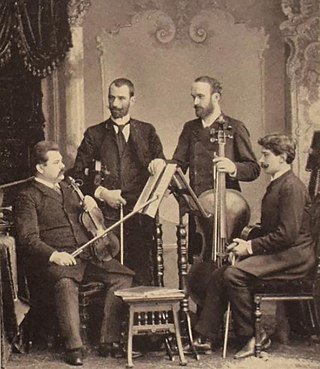
The Brodsky Quartet was a string quartet led by Adolph Brodsky. It was established on 1884, while Brodsky was professor at the Leipzig Conservatoire. The founding members, aside from Brodsky were Ottokar Nováček, Hans Sitt (viola) and Leopold Grützmacher (violoncello).
The Brodsky Quartet was the second string quartet established and led by violinist Adolph Brodsky.
Sir Edward Elgar wrote his Violin Sonata in E minor, Op. 82, in 1918, at the same time as he wrote his String Quartet in E minor and his Piano Quintet in A minor. These three chamber music works were all written at "Brinkwells", the country house near Fittleworth in West Sussex that Lady Elgar had acquired for her husband to recuperate and compose in, and they mark his major contribution to the chamber music genre. His Cello Concerto in E minor of 1919 completed the quartet of introspective and melancholy works that comprised Elgar's last major creative spurt before his death in 1934.
Raymond Jeremy, FRAM, (1890-1969) was a British violist, known for his quartet playing, particularly the first performances of Edward Elgar's String Quartet and Piano Quintet. He was professor of violin and viola at the Royal Academy of Music in London and taught the violist Watson Forbes.
References
- Kennedy, Michael (1987). Portrait of Elgar (Third ed.). Oxford University Press. ISBN 0-19-284017-7.
- McVeagh, Diana (2007). Elgar the Music Maker . Woodbridge, Suffolk: Boydell Press. ISBN 978-1-84383-295-9.
- Moore, Jerrold Northrop (1984). Edward Elgar: A Creative Life. Oxford University Press. ISBN 0-19-315447-1.
- Newbould, Brian (1996). "′Never Done Before′: Elgar's Other Enigma". Music & Letters. 77 (2): 228–241. doi:10.1093/ml/77.2.228. JSTOR 737196Accessed.
- Reed, W. H. (1946). Elgar. London: Dent. OCLC 8858707.